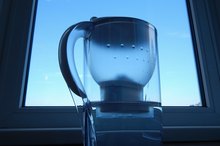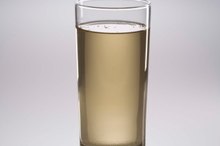What Are the Dangers of Not Changing a Drinking Water Filter Often Enough?
Contaminants come in sizes just like shoes, beads and fountain drinks. A drinking water filter is designed to capture certain sizes of contaminants 1. This means a filter may not be designed to capture all of them and the ones they do capture can build up in the filter over time. The purpose of a drinking water filter is to remove contaminants before they are ingested 1. Not changing a filter often enough will alter the quality of water received 2.
What Water Filters Do
Charcoal and carbon drinking water filters are designed to capture contaminants in several ways 13. One way is trapping the contaminant because its size cannot pass through the filter. Some contaminants are caught because they adhere or are absorbed into the filter's surface. A noticeably slowing flow rate is an indicator of an “over-trapped” filter meaning the larger contaminants are clogging the filter preventing the water from a more rapid flow.
- Charcoal and carbon drinking water filters are designed to capture contaminants in several ways 1.
- One way is trapping the contaminant because its size cannot pass through the filter.
Contaminants
Disadvantages of Water Filters
Learn More
Contaminants that are absorbed or adhere to the filter are much harder to track than the larger contaminants. As the filter is used there is a point where it begins to lose its ability to trap and adhere contaminants. It becomes full and cannot do its job. This means contaminants are now flowing into the drinking water 1. This is why changing the filter as directed by the manufacturer is important. Even if the filter does not have a reduced water flow there are still unseen contaminants in the filter.
- Contaminants that are absorbed or adhere to the filter are much harder to track than the larger contaminants.
- As the filter is used there is a point where it begins to lose its ability to trap and adhere contaminants.
Mold In Used Filters
Water filters that have been overused and those that go unused for weeks (whether overused or not) should be removed and the pitcher should be thoroughly cleaned 3. Contaminants can rot in the filter. Left unmonitored they can begin to grow mold, especially in a humid location. Not only does the mold make the water taste bad, it is possible to ingest the mold through a moldy water filter. Ingestion can cause:
- headaches
- runny nose
- sinus problems
- skin rash
- diarrhea
- possible vomiting
- Water filters that have been overused and those that go unused for weeks (whether overused or not) should be removed and the pitcher should be thoroughly cleaned 3.
- Not only does the mold make the water taste bad, it is possible to ingest the mold through a moldy water filter.
Expired Water Filters
Water Filters That Remove Scale
Learn More
Water filters are designed to filter a particular amount of water noted in gallons on the filter label 3. Most manufacturers include a time frame (usually three to six months) for filter use. Continued use after the suggested expiration date could mean ingesting water that is more contaminated than before it is filtered. Proctor and Gamble's PUR Water Filtration System includes a water pitcher that has a built in electronic indicator that tracks the filters life 3. Its indicator light is contained on the lid and lights up when the filter needs changing.
Hard Water And Filters
Locations that have hard water pose a risk to those using filters for drinking water 13. Hard water causes the filters to expire faster 3. This is because hard water has far more sediment (impurities) in it than softer water. Hard water sediment clogs the filter faster leaving the filter to allow other impurities to pass through. It may be necessary to change the drinking water filter in hard water locations more often than recommended 1.
Related Articles
References
- Drinking Water Fact Kit
- Water Quality Association
- Mcevoy RD, Antic NA, Heeley E. CPAP for Prevention of Cardiovascular Events in Obstructive Sleep Apnea. New England Journal of Medicine. 2016;375(10):919-931. doi:10.1056/nejmoa1606599
- Donovan LM, Boeder S, Malhotra A, Patel SR. New developments in the use of positive airway pressure for obstructive sleep apnea. J Thorac Dis. 2015;7(8):1323–1342. doi:10.3978/j.issn.2072-1439.2015.07.30
Writer Bio
Alex Burke holds a degree in environmental design and a Master of Arts in information management. She's worked as a licensed interior designer, artist, database administrator and nightclub manager. A perpetual student, Burke writes Web content on a variety of topics, including art, interior design, database design, culture, health and business.









